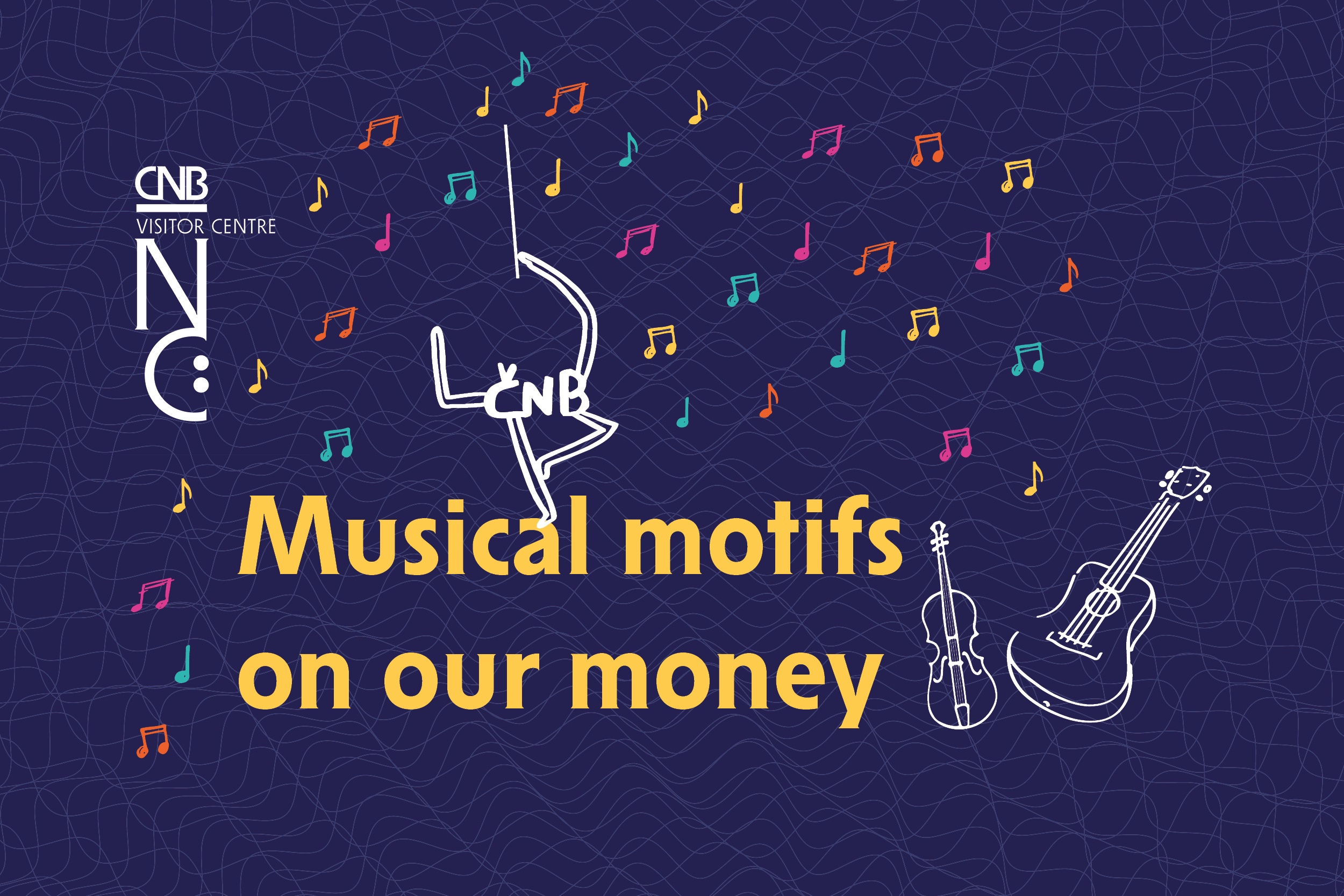Musical motifs on our money

People sometimes claim that certain sayings and truisms are no more than clichés today. "Every Czech is a musician" is said to be one of them. This saying probably originated because learning a musical instrument was a very normal part of education in the Czech Lands. As a result, the country produced many exceptionally talented musicians whose output became popular across the world. No wonder that music and its leading lights are a frequent motif on Czech money.
Looking at the history of Czech music through the lens of our money, the earliest depicted personality is the Czech politician, traveller, writer and composer mainly of church music, Kryštof Harant of Polžice and Bezdružice (1564-1621). He featured on a commemorative silver coin issued in 2014 to mark the 450th anniversary of his birth. Besides his portrait, the obverse side of the coin features his favourite instrument - the lute. The next personality in chronological order is the composer and music teacher Jakub Jan Ryba (1765-1815), whose Czech Christmas Mass featured on a 1996 commemorative coin.
The opera Dráteník (The Tinker) and the music from the farce Fidlovačka aneb Žádný hněv a žádná rvačka (Fidlovačka, or No Anger and No Brawl), in which the current Czech anthem was heard for the first time, were written by František Škroup (1801-1884), conductor at the Estates Theatre. He features on a 2001 commemorative silver coin (CZK 2001 I), symbolically opening perhaps the most famous period of Czech music. In addition to Bedřich Smetana (1824-1884), who is the most frequently depicted composer on Czech money (the CSK 5000 1946 and CZK 1000 1985 banknotes and the CSK 100 1974 commemorative silver coin), this era includes Antonín Dvořák (1841-1904, CSK 100 1991 I), František Kmoch (1848-1912, CZK 200 1998 III), Zdeněk Fibich (1850-1900, CZK 200 2000 IV), Leoš Janáček (1854-1928, CZK 200 2004 IV) and the Czech-Austrian Gustav Mahler (1860-1911, CZK 200 2010 II). Worth mentioning is the coin marking the 150th anniversary of the birth of Antonín Dvořák, whose Symphony No. 9 in E minor (New World Symphony) reached the surface of the Moon in 1969, as astronaut Neil Armstrong took a tape recording of it with him. For this coin, Jiří Harcuba created a distinctive depiction of Antonín Dvořák's profile, accompanied by the composer's signature embedded in a stave.
The list of Czech composers on Czech money is rounded off with Jaroslav Ježek (1906-1942, CZK 200 2006 V), whose swing and jazz improvisations and compositions accompanied the plays of the Prague Free Theatre. That's why two clowns - Jiří Voskovec and Jan Werich - appear with him on the coin, evoking their play Rub a líc (Heads or Tails).
However, our money also bears depictions of some important musical performers. The name of opera singer and writer Ema Destinová, born Emilie Pavlína Věnceslava Kittlová (1878-1930), will probably come as no surprise. She is depicted on the CZK 2000 banknote, accompanied on the reverse side by a motif of Euterpe, the Greek muse of music. In addition, the opera soprano Jarmila Novotná and the opera tenor Beno Blachut feature on CZK 200 commemorative silver coins (1907-1994, CZK 200 2007 III and 1913-1985, CZK 200 2013 III respectively).
Several commemorative silver coins are also devoted to musical institutions. Besides the National Theatre, which featured on the face side of the above-mentioned CZK 5000 banknote of 1946 and later on silver commemorative coins issued in 1968 (CSK 10 1968) and 1983 (CSK 100 1983 IV and CSK 500 1983) and is thus one of the most frequent motifs on Czech money, these include the Czech Philharmonic (CZK 200 1995 IV), the Prague Conservatory (CZK 200 2011 I), the Municipal House (CZK 200 2012 VI) and of course the Estates Theatre. Its reopening on the anniversary of the death of Wolfgang Amadeus Mozart (1756-1791) was marked by a silver coin (CSK 100 1991 II). On this coin, the designer Jiří Harcuba depicted the profile of the genius composer against the background of the building of the theatre where Mozart's Marriage of Figaro met with such success that he praised the music lovers of the city by saying "the people of Prague understand me". Recently, these issues were joined by a coin marking the anniversary of the launch of Czechoslovak Radio (CZK 200 2023), which offered its listeners a wide variety of music from the very beginning.
The list of music-related personalities and institutions that have appeared on Czech and Czechoslovak money goes on and on. This refutes the view that the saying "Every Czech is a musician" is a mere cliché. Let us draw attention to two personalities whose important anniversaries we will celebrate this year. The first is the Father of the Nation, František Palacký (1798-1876), who was, among other things, a musicologist and founder of the music department of the Czech patriotic museum (today the National Museum) and whose piano-playing skills were admired by guests of the Měchura family, into which he married. The second is Vilém Pospíšil (1873-1942), first governor of the National Bank of Czechoslovakia, who, it is said, was undecided for a long time between becoming a professional pianist and pursuing the career of a financial manager. Palacký featured on two banknotes (CSK 100 1931 III and CZK 1000 1993 and later versions) and a commemorative silver coin (CZK 200 1998 II). Pospíšil was depicted by the Czech sculptor and medallist Vladimír Oppl on a CZK 20 coin (CZK 20 2019 II). The painter Eva Hašková is currently working on a commemorative banknote devoted to him.



